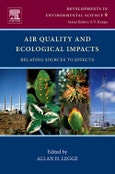Air Quality and Ecological Impacts reviews the characterization of air quality as it pertains to specific emission sources and their environmental effect. Since emissions from multiple sources impact the same location, a multidisciplinary approach is needed to relate atmospheric processes to terrestrial vegetation. As global industrial expansions continue, air quality is no longer governed by isolated point sources (e.g., a single coal-fired power plant), but by source clusters or complexes. To address these issues, atmospheric receptor models have been developed and are continually being improved. The benefits of any air quality control measures based on receptor modeling must be verified by assessing changes or bettering in environmental impacts. Until now, such an approach has not been well integrated and practiced. This book provides the needed concepts and methods in conducting the studies to establish cause-and-effect relationships under ambient conditions, which is valuable to policy makers both in industrialized and developing nations.
Please Note: This is an On Demand product, delivery may take up to 11 working days after payment has been received.
Table of Contents
1. Introduction Allan H. Legge2. Theory and Application of Atmospheric Source Apportionment Philip Hopke
3. Use of Trace Metals as Source Fingerprints Richard L. Poirot
4. Plants as Accumulators of Atmospheric Emissions J. Neil Cape
5. Relating Source-Specific Atmospheric Sulfur Dioxide Inputs to Ecological Effects Assessment in a Complex Terrain José Luis Palau, Sagar Krupa, Vicent Calatayud, Maria Sanz and Millán Millán
6. Negative vs. Positive Functional Plant Responses to Air Pollution: a Study Establishing Cause-Effect Relationships of SO2 and H2S L. J. De Kok, L. Yang, C. E. E. Stuiver, and I. Stulen
7. Hormesis: Its Relevance in Phytotoxicology H.-J. Jäger and S. V. Krupa
8. Evaluating Ozone Effects on Growth of Mature Trees with High Resolution Dendrometer Systems S. B. McLaughlin and M. Nosal
9. Methods for Measuring Atmospheric Nitrogen Deposition Inputs in Arid and Montane Ecosystems of Western North America M.E. Fenn, J.O. Sickman, A. Bytnerowicz, D.W. Clow, N.P. Molotch, J.E. Pleim, G.S. Tonnesen, K.C. Weathers, P.E. Padgett, and D.H. Campbell
10. Air Quality Changes in an Urban Region as Inferred from Tree-Ring Stable Isotopes M. M. Savard, C. Bégin, J. Marion, J.-C. Aznar, and A. Smirnoff
11. Lichen Monitoring of Urban Air Quality, Hamilton, Ontario D. P. McCarthy, B. Craig, and U. Brand
12. Ozone Exposure-Based Growth Response Models for Trembling Aspen and White Birch K. E. Percy, M. Nosal, W. Heilmanc, J. Sober, T. Dann and D. F. Karnosky
13. Closing Remarks Sagar Krupa and Allan H. Legge
Authors
Allan H. Legge Biosphere Solutions,Calgary, Alberta, Canada.








